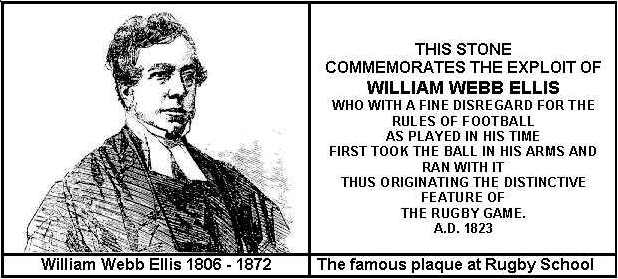
William Webb Ellis, or Bill to his friends, was a pupil at the famous Rugby School in Warwickshire, central England, during the early 19th century. This was, and still is, one of the best schools in England
According to the story told to generations of schoolboys, the 15-man game of Rugby Union began in 1823 when Ellis, then a 16 year old schoolboy caught the round ball and instead of standing still, he ran with it during a football training session. Trying to catch him, he and his friends invented the game of Rugby Football later to become Rugby Union. When anyone since has spoken about the declining sportsmanship in Rugby Union, others have used this story to counter with the fact that the game was born out of act of foul play.
That's the story but how much is really known about this incident?
Like many such tales, fact and myth have become interwoven during the course of time. William was certainly a pupil at Rugby from 1816-1825 and a plaque on the grounds records his role in founding the sport that bears the school's name. While many historians agree that Rugby School played a role in founding the sport they are less certain about Webb Ellis's part in the creation of rugby.
This much is known about the man himself. William Webb Ellis was born on the 24th of November in Manchester, northwest England, in 1806. After his soldier father died, his mother moved to Rugby so her sons could attend the local school and gain an education as local foundationers
During the seven years he attended the school William was successful both at sports and academically. He won an Exhibition (a type of scholarship) to Brasenose, Oxford. Here he proved himself to be a good cricketer, representing Oxford University in their annual match against Cambridge University and so winning his 'Blue'. This is an honour given from the University to sportsmen and women of outstanding achievement.
After graduation he took Holy Orders and was ordained. Webb Ellis soon became chaplain of St George's Church, Albemarle, London. At the time of the Crimean War, he was Rector of St Clement Danes in the Strand, when the Illustrated London News printed the picture we can see above. Ironically for someone so closely associated with England, Webb Ellis died in Menton on the 24th of January 1872, aged 65. He was buried in Menton in Southern France.
Nobody ever asked William Webb Ellis about his exploit, since it first came to light in 1876, four years after his death, when Matthew Bloxam a Rugby pupil and later a journalist, wrote to the Rugby School magazine with a description of the incident that he had apparently recently obtained from an anonymous eye-witness. Bloxam did not see Webb Ellis pick up the ball and run with it but was told about William's actions during the game. But by the time the first detailed investigations into Bloxam's account of what happened began in 1895, eye-witnesses were hard to track down.
When the Old Rugbeian Society began to research the history of the game in 1895, Bloxam also had died, some 7 years before. Naturally they had difficulty finding anyone who remembered William Webb Ellis, and most of their correspondents, who had been at school during the 1830's, had never heard of him. In general they remembered running with the ball as being of dubious legality.
The exception was the Reverend Thomas Harris, who had been junior to William Webb Ellis and thus had never seen him play. He remembered him well, but he had never heard of the exploit and was adamant that in his playing days, just after William Webb Ellis left Rugby, running with the ball was not allowed.
It therefore seems clear that there is little historical fact to back up the original story.
During the 19th century it was common for fee-paying boys' schools in England such as Rugby to develop their own types of football. Some researchers have suggested that Webb Ellis, whose father had been stationed in Ireland, was merely demonstrating the ancient Irish game of 'caid' which was similar to rugby. Given the nature of the game and its organisation in those days, and comments from some of the correspondents, it is probable that many boys ran with the ball at one time or another. By chance one name has been thrown up, and the Old Rugbeian Society pulled a brilliant Public Relations stroke in phrasing the famous plaque on the Headmaster's garden wall (see quote above) - their actual report is much more cautious.
It was not until 1863 when the Football Association, still the sport's governing body in England, was formed that the rules for soccer were first codified. Rugby did not get its own set of laws until 1871, a year before Ellis's death, with the foundation of the Rugby Football Union which continues to administer the game in England to this day.
Despite all this, the Rugby World Cup with its Webb Ellis trophy has probably ensured that many who know little else about this great game will continue to believe. Thanks to this his name lives on.
After all, like any good myth, it is more entertaining than the historical facts